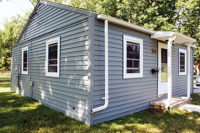When the U.S. economy took a downturn during the Great Recession, the refrain everyone heard again and again was “repair, don’t replace.” But, even as the economy has improved, some building owners and operators remain hesitant to make large capital expenditures to replace older chiller systems. In these cases, there are less expensive options available that can enable decision makers to achieve substantial efficiency upgrades by retrofitting their chillers.
“I’m hearing from customers that there are still some doubts lingering in their minds regarding the financial stability of the market, and that is prompting them to hang on to their capital,” said Robert Gray, national sales manager, Schneider Electric.
Chiller retrofits can provide a solution to extend the life of existing systems while allowing owners and operators to “postpone the decision to replace an entire chiller,” said David Sylves, director of marketing, Bitzer US Inc.
“The upgrade cost is much less than the cost of a new chiller, and it may add many years to the chiller’s life,” he added.
Tom Reynolds, sales manager at ACCO Engineered Systems in Glendale, California, noted his company has retrofitted chillers for a range of clients, including telecom, office buildings, hospitality, education, and health care. Sometimes, he said, his team is called in for an emergency repair, but, in other cases, clients become interested in a retrofit after consulting with ACCO about their needs for improved efficiency and reliability.
Reasons to Retrofit
Not only is the initial financial investment reduced in a retrofit, there are also significant cost savings that can be achieved going forward. That’s because retrofit upgrades offer significant energy savings, Sylves said.
Gray has perfected the question he asks prospective clients when gauging their interest in the savings made possible by a chiller retrofit.
He asks customers the following: “Regarding your existing chiller, if I could show you a way to decrease your energy expense by as much as 30 percent, bring your existing chiller up to the peak efficiency standards of today, work with your utility company to obtain a rebate, and provide a retrofit project with an ROI [return on investment] of three years or less — all for a fraction of the cost of replacement — is this something that would interest you?”
For those who are looking to decrease the amount they spend on energy, their interest is certainly piqued. Reynolds noted the efficiency gains depend on the existing system. “It varies case-by-case,” he said, adding ACCO’s engineering department analyzes expected efficiency for each client.
Another reason owners may turn to retrofits is uncertainty about refrigerant regulations.
“Some building owners are reluctant to install a new chiller today without knowing which refrigerants will be phased out during the lifetime of their system,” Sylves said. “Consequently, they may choose to retrofit their current chiller’s compressors now and stay with R-22 in the short term, or perhaps change to R-407C or R-134a.”
Options and Solutions
Whatever their reasons, building owners and contractors can find a variety of options and solutions available in today’s market to upgrade chillers and reduce energy usage.
According to Sylves, “Bitzer has a robust retrofit upgrade program available for its dealers. Old, inefficient screw, and large, semi-hermetic reciprocating compressors of various types and brands are being replaced with high-efficiency screw compressors that dramatically reduce a chiller’s power consumption.”
He also noted Bitzer offers two series of screw compressors.
“One is optimized for systems with high condensing temps, and another series is optimized for low condensing temps,” Sylves said. “This differentiation enables our dealers to select the most energy-efficient compressor in its class for a retrofit upgrade.”
Gray highlighted Schneider Electric’s Condenser Fan Pak (CFP) as a plug-and-play solution for retrofitting air-cooled chillers. He explained it “incorporates floating high-pressure control with VFD [variable frequency drive] condenser fan operation.”
Going into more detail, Gray described how the CFP works to reduce energy usage.
“Floating high pressure takes advantage of off-design use of the chiller,” he said. “In most cases, chillers are sized at an outdoor dry bulb temperature of 95°F. Ninety-five percent of the time, the chiller operates below that outside air temperature. This means the condenser is oversized for all outdoor operating temperatures below 95°. This enables the CFP to reduce the condensing temperature through the condenser by modulating the airflow by varying the speed of the condenser fans. By reducing the condensing temperature, we float the head pressure down, which reduces the lift on the compressor. Reducing the lift on the compressor reduces the amount of work the compressor has to perform, which decreases its energy consumption.”
Retrofit Results
Both Gray and Sylves shared examples of applications where their solutions have been used to successfully upgrade existing chiller systems.
A six-month customer field test was conducted for an air-cooled chiller used in a typical commercial application,” said Gray. “The scheduled daily operation of the chiller was 6 a.m. to 10 p.m. During the hours of operation, the chiller was automatically switched between the original OEM controls and the Schneider Electric CFP. With each run cycle, kilowatt-hour measurements were taken. The field test confirmed the CFP saved approximately 30 percent kW.”
Gray also mentioned two schools that were retrofitted with CFPs, noting the first anticipated savings of $5,000 per year, and the second, $7,000 per year — and both had applied for matching utility company rebates.
Sylves referenced a retrofit performed on two 11-story medical office buildings in California. The buildings’ existing R-22 systems were converted to R-134a, and eight high-efficiency Bitzer 150-ton screw compressors were specified as part of the conversion. Ultimately, Sylves said, the retrofit “earned a $250,000 utility rebate from the Los Angeles Department of Water and Power.”
These types of utility rebates are only further proof that, for those who are looking to save money on energy, a chiller retrofit may be just the answer they are seeking.
Publication date: 5/11/2015
Want more HVAC industry news and information? Join The NEWS on Facebook, Twitter, and LinkedIn today!













